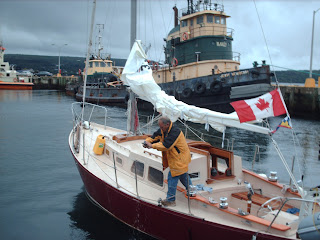Upon arrival at the western entry to the Canso Causeway we were extremely surprised by the calmness of the waters of the strait which is unusual. I was at the helm until we approached the Lock and I mentioned to the captain that I could really notice the difference on the wheel. The wheel seemed so responsive that it almost talked back to me and I informed the captain that I hadn`t felt it that light since the calm waters of the entrance to the St Lawrence at Kingston. It remained that way all the way through the 14 nautical miles of the strait.
The Canso Causeway is a half a mile long and its depth is about 55 meters and the Canso Lock is located at the far end closest to the Cape Breton Island side as one approaches it. When the Causeway was built in 1955 it created one of the deepest ports on the east coast of North America and eliminated the heavy current that ran through it. Now some of the largest ocean going super oil tanker vessels ever built could enter at Port Tupper. The lock lift is minimal at 1.2 meters in comparison to the seaway locks but the procedure is almost identical ( except that this one is free) in that one must inform the lockmaster of their arrival and wait for the proper instructions and green light before proceeding through. The Lockmaster asked for a report of our information: who we were, the name of our vessel, her registration number, her draft and tonnage, how many individuals were on board, our nationality, our home port, where we were coming from and our next port of call – all the usuals. Once he had received our info, the lockmaster informed us that we would be the only vessel in the lock so we would not tie to the wall but remain in the centre of the lock and await the opening of the doors to motor through. Upon the exit of the lock the huge gravel pit located at Cape Porcupine on the opposite side of the Causeway is clearly visible. It has an interesting vessel loading procedure where the gravel is pushed over the top of the Cape onto a conveyor belt that receives the gravel to drop it into the holds of ships at the wharf far below.
Two nautical miles further up the Strait we entered the Port Hawkesbury Marina at 4pm to find its much needed fuel dock closed until the following morning. We secured to the floating dock for the evening, walked up the hill into town to the bank and for a few needed supplies.
The following morning brought rain and heavy fog. It appeared we were not moving far that day but by 3pm the fog lifted enough for us to make it out to the eastern mouth of the Strait of Canso.
We had refuelled earlier in the day and by 5pm we were safely on our way to the little wharf at Eddy`s Point harbour 14nm closer to home.








No comments:
Post a Comment